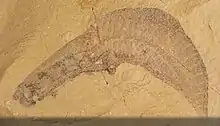Yunnanozoon
Yunnanozoon lividum (Yunnan + Greek ζῷον zôion, lividum; "livid animal of Yunnan") is an extinct species of possible vertebrate or chordate from the Lower Cambrian, Chengjiang biota of Yunnan province, China. It is thought of as a deuterostome suspected of being either a hemichordate[1] or chordate.[2] In 2022, a study reanalyzed fossils of Yunnanozoon and found it to be one of the earliest members of the vertebrate family tree.[3]
| Yunnanozoon Temporal range: Cambrian Series 2, | |
|---|---|
 | |
| Artist's restoration of Yunnanozoon as a chordate. | |
 | |
| A fossil of Yunnanozoon lividum | |
| Scientific classification | |
| Domain: | Eukaryota |
| Kingdom: | Animalia |
| Phylum: | Chordata |
| Family: | †Yunnanozoonidae Dzik, 1995 |
| Genus: | †Yunnanozoon Hou, Ramskold & Bergstrom, 1991 |
| Species: | †Y. lividum |
| Binomial name | |
| †Yunnanozoon lividum Hou, Ramskold & Bergstrom, 1991 | |
| Synonyms | |
Yunnanozoon is similar to the form Haikouella,[4] which is almost certainly a chordate. Still, there are anatomical differences from Haikouella, including a smaller stomach and much larger (1 mm) pharyngeal teeth. It is by no means certain whether Yunannozoon possessed features such as a heart, gills, etc., which are seen in well-preserved specimens of Haikouella. Yunnanozoon somewhat resembles the Middle Cambrian Pikaia from the Burgess shale of British Columbia in Canada. Thirteen pairs of symmetrically arranged gonads have been identified, as have possible gill slits. However, some authors think that Yunnanozoon is closely related to the chordate Haikouella and that Yunnanozoon is probably a chordate rather than a hemichordate. A close relationship between Yunnanozoon and the taxon Vetulicolia has also been proposed.
An analysis in 2015 placed Haikouella as a junior synonym of Yunnanozoon.[5][6]
See also
References
- Shu, D.; Zhang, X.; Chen, L. (1996). "Reinterpretation of Yunnanozoon as the earliest known hemichordate". Nature. 380 (6573): 428–430. Bibcode:1996Natur.380..428S. doi:10.1038/380428a0. S2CID 4368647.
- Sepkoski, J. John (2002). Jablonski, David; Foote, Michael J. (eds.). A compendium of fossil marine animal genera. Ithaca, N.Y.: Paleontological Research Institution. ISBN 0-87710-450-6. OCLC 50682622.
- Tian, Qingyi; Zhao, Fangchen; Zeng, Han; Zhu, Maoyan; Jiang, Baoyu (8 July 2022). "Ultrastructure reveals ancestral vertebrate pharyngeal skeleton in yunnanozoans". Science. 377 (6602): 218–222. Bibcode:2022Sci...377..218T. doi:10.1126/science.abm2708. ISSN 0036-8075. PMID 35857544. S2CID 250380981.
- Chen (2009). "The sudden appearance of diverse animal body plansduring the Cambrian explosion". The International Journal of Developmental Biology. 53 (5–6): 733–751. doi:10.1387/ijdb.072513cj. PMID 19557680.
- Cong, Pei-Yun; Hou, Xian-Guang; Aldridge, Richard J.; Purnell, Mark A.; Li, Yi-Zhen (2015). Smith, Andrew (ed.). "New data on the palaeobiology of the enigmatic yunnanozoans from the Chengjiang Biota, Lower Cambrian, China". Palaeontology. 58 (1): 45–70. doi:10.1111/pala.12117. S2CID 84567733.
- Tian, Qingyi; Zhao, Fangchen; Zeng, Han; Zhu, Maoyan; Jiang, Baoyu (8 July 2022). "Ultrastructure reveals ancestral vertebrate pharyngeal skeleton in yunnanozoans". Science. 377 (6602): 218–222. Bibcode:2022Sci...377..218T. doi:10.1126/science.abm2708. ISSN 0036-8075. PMID 35857544. S2CID 250380981.
External links
- A picture can be found at https://web.archive.org/web/20030511135309/http://www.gs-rc.org:80/repo/repoe.htm